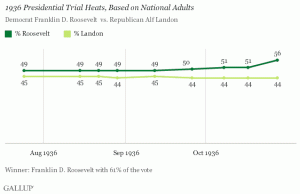Does anyone remember Alf Landon? No, right. In 1936, Landon was predicted by the Literary Digest, a respected magazine at the time, to win in a landslide over incumbent President Franklin D. Roosevelt. Literary Digest had predicted correctly the last five elections, but this one mistake would change the landscape of exit polling for years to come.
The Literary Digest distributed 10 million questionnaires to voters who had automobiles, telephone subscribers, and country club memberships. They received back only 23% of those questionnaires and from those results determined that Landon would defeat President Roosevelt by a 3 to 2 margin.
At the same time a young rival pollster, George Gallop, made a prediction. He predicted that the Literary Digest would get it all wrong before they even published the poll. As you can see, Gallup was right.
Where did the Literary Digest get it all wrong?
The erroneous prediction came from the distribution of their polling population. In 1936, automobiles, telephone subscription and country club memberships were not affordable to the average voter. The sample population did not represent the general voting population.
Gallup made his prediction from a random sample of 50,000 people and, as you can see from the chart above, predicted that FDR would win reelection. FDR won with 61% of the vote and more than 11 million votes over Landon, a huge landslide in those days.
Measuring public opinion is no easy task but thanks to the faulty sampling method by the Literary Digest, Gallup would be established as the nation’s preeminent pollster.



Leave a response